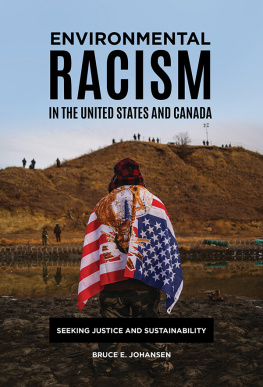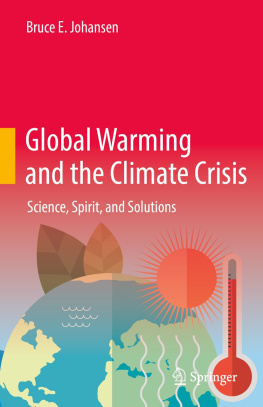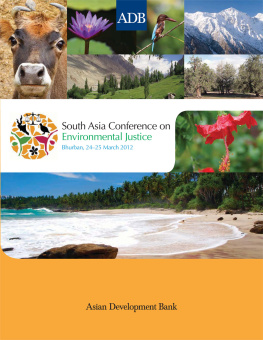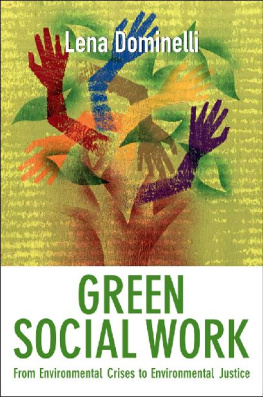Environmental Racism in the
United States and Canada
Environmental Racism in the
United States and Canada
Seeking Justice and Sustainability
Bruce E. Johansen

Copyright 2020 by ABC-CLIO, LLC
All rights reserved. No part of this publication may be reproduced, stored in a retrieval system, or transmitted, in any form or by any means, electronic, mechanical, photocopying, recording, or otherwise, except for the inclusion of brief quotations in a review, without prior permission in writing from the publisher.
Library of Congress Cataloging-in-Publication Control Number: 2019059502
ISBN: 978-1-4408-6402-5 (print)
978-1-4408-6403-2 (ebook)
24 23 22 21 20 1 2 3 4 5
This book is also available as an eBook.
Praeger
An Imprint of ABC-CLIO, LLC
ABC-CLIO, LLC
147 Castilian Drive
Santa Barbara, California 93117
www.abc-clio.com
This book is printed on acid-free paper 
Manufactured in the United States of America
Contents
Preface
Environmental Racism in the United States and Canada: Seeking Justice and Sustainability traces the relationship between environmental discrimination, race, and class. The idea for the book originated with ABC-CLIOs editorial board. It is directed at anyone who has an interest in social justice and environmental issues, but it is especially designed for high school students in advanced placement courses as well as college undergraduates. Readers will receive an enhanced understanding of how poor and minority people are affected by environmental crises ranging from chemical pollution to floods spawned by hurricanes made worse by climate change.
Environmental racism and the pursuit of justice against it intertwines ecology with issues of race and class, involving poor, often racial minority communities whose residents are subjected to a disproportionate level of many kinds of toxicity, while being denied ecological benefits such as clean water and air, as well as sustainable use of resources for a decent and dignified standard of living.
This work is organized into five background essays, which provide an overview of the subject, followed by case studies grouped by regions in the United States and Canada, including the eastern half of the United States, the western half of the United States, and Canada. We have extended the scope to Canada because quite a number of environmental law and racism issues (often those involving Inuit and other indigenous peoples) stem from there. Some of these are quite important on a global basis, for example, the toll that persistent organic pollutants (POPs) have been taking on the Inuit. Often they cant eat fish or seals, staples in their traditional diet. Eating food flown in from lower latitudes is not only culturally out of character, but very expensive. Inuit mothers cannot breastfeed their babies because toxins such as dioxin biomagnify up the food chain (their effects increase exponentially at each step). The Canadian Inuit have taken a lead role globally in measures such as the Stockholm Convention, which outlaw many POPs.
The background essays and case studies are mainly contemporary, but also include some historic accounts from as early as the nineteenth century.
CHAPTER ONE
Background
What Is Environmental Justice?
Environmental racism and the pursuit of justice against it intertwines ecology with issues of race and class, involving poor, often racial minority communities whose residents are subjected to a disproportionate level of many kinds of toxicity, while being denied ecological benefits such as clean water and air, as well as sustainable use of resources for a decent and dignified standard of living. Benjamin Chavis, an activist in both environmental and civil rights, has said that environmental racism is racial discrimination in environmental policy-making and enforcement of regulations and laws, the deliberate targeting of communities of color for toxic waste facilities, the official sanctioning of the presence of life-threatening poisons and pollutants for communities of color, and the history of excluding people of color from leadership of the environmental movement (Chavis, 1987). In a worldwide context, environmental racism also has been used to describe the movement of polluting industries, with their toxicity, from affluent nations to the Third World. Thus in the last century the worst air quality in the world has moved from urban areas such as New York City and London to such cities as Beijing and New Delhi.
Environmental racism and the environmental justice that addresses it unite human and civil rights with acute ecological crises. The road through this thicket is paved with human stories fraught with suffering and deathhuman agony inflicted by several types of cancer and many other maladies borne usually by poor, nonwhite people who are already ailing, stuck at the bottom in a world increasingly laced with growing income inequity from all manner of pollution that is a by-product of modern industry. As a scholarly pursuit, environmental racism and justice can be traced to the 1970s. In Indian Country, however, writes Zoltn Grossman in Unlikely Allies: Native American and White Communities Join to Defend Rural Lands (2017, 103), the environmental justice movement could be traced back to 1492with the arrival of a certain Italian interested in mining gold.
Robert D. Bullard has defined environmental justice as the fair treatment and meaningful involvement of all people regardless of race, color, national origin or income with respect to the development, implementation, and enforcement of environmental laws, regulations, and policies. Bullard said that fair treatment should be defined in a way that inflicts no single racial, ethnic, or socioeconomic group with a disproportionate share of pollution from industrial, municipal, and commercial operations. Simply put, wrote Bullard, environmental justice demands that everyone (not just the people who can vote with their feet and move away from threats or individuals who can afford lawyers, experts, and lobbyists to fight on their behalf) is entitled to equal protection and equal enforcement of our environmental, health, housing, land use, transportation, energy, and civil rights laws and regulations (Bullard et al., 2007).
Environmental racism also has been defined as the disproportionate burden of environmental problems on people of color (Gottlieb, 2005). The primary goal of environmental justice scholarship has been to document the correlation between polluting industries and environmental health, involving the economics and politics of race and class and proximity to injury. It afflicts economically deprived people of all races, because poor whites, as well as poor people of color, end up in run-down houses near chemical plants, or find themselves on floodplains without insurance as hurricanes roll in. Environmental justice is what socially conscious people are doing (or would like to do) about these inequities.
The sheer ubiquity of toxic effluent in communities of color may be increasing even as programs such as the U.S. Environmental Protection Agencys Superfund program (which contained more than 1,300 sites in 2018) seeks to cleanse some of them. Coal-fired power plants that supply cities often are sited in rural areas, often within sight of poor nonwhite communities whose residents rely on easily polluted wells for water. Consider Walnut Tree, a mainly African American town near Duke Energys Belews Creek Steam Station in North Carolina. Margaret Talbot wrote in the New Yorker
Next page








